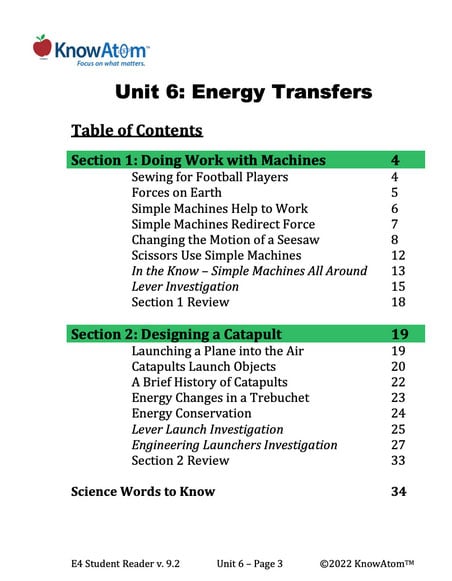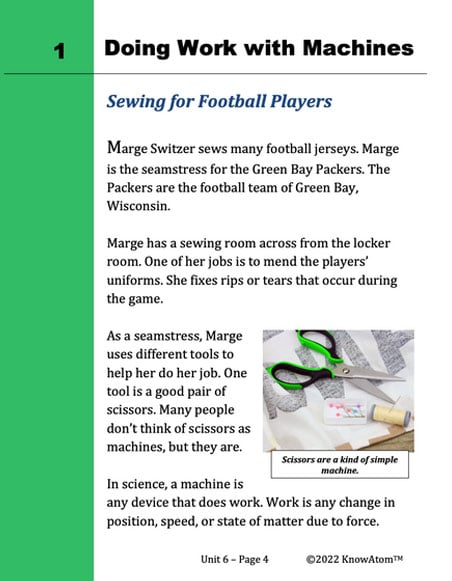In this lesson students investigate the phenomena of systems where potential energy to kinetic energy transfers occur that can launch projectiles.
In this lesson students focus on phenomena created by levers, exploring how the structure of the lever determines how much force it can produce to do work. This page is a high-level extract showcasing various parts of the lesson.
Science background provides teachers with more in-depth information on the phenomena students explore in this unit about energy transfer. Here is an excerpt from the science background section for this lesson.
If you’ve ever kept a door open using a doorstop or dug a hole in the garden with a shovel, you’ve used another kind of simple machine—a wedge. A wedge is a triangular tool with at least one slanting side ending in a sharp edge that separates or holds objects in place.
And anytime you’ve ridden in an elevator, you’ve moved up and down because of pulleys. A pulley is made up of a grooved wheel and a rope or chain that raises, lowers, or moves a load.
Pulleys are also how window blinds and drapery are opened and closed. When one side of the rope or chain is pulled down, the other side moves up. If there is an object attached to the other side, it moves up as well. Pulleys reduce the amount of effort needed because they use the downward pull of gravity to maximize the force needed to pull down on the rope. In other words, the force you apply to the rope is increased because gravity is also pulling in the same direction. This means you can use less force to lift the object the same height as you would have to use if you just lifted the object straight up.
This is a mechanical advantage, which occurs when the machine increases the force output compared to the amount of force input. If the output force is larger than the input force, a machine has a mechanical advantage greater than one. If a machine increases an input force of 10 joules to an output force of 100 joules, the machine has a mechanical advantage of 10. The joule is a unit of energy.
The final kind of simple machine is a lever, which is a stiff beam that rests on a pivot point called a fulcrum that lifts or moves loads. Students will focus on levers in this unit. Scissors, which are commonly used by seamstresses such as Marge Switzer of the Green Bay Packers, are two levers put together.
Scissors work because as you move the two handles together, you apply a force to the scissors handle. This force is called an effort force because it is the force you apply to a machine. That effort force transfers the energy of your moving hands to the scissors.
The scissors redirect the effort force from the handle to the blades. This causes the blades to move, producing a load force. A load is an object that a simple machine moves or the force that the simple machine must overcome. When the sharpened blades slide against one another, they cut whatever material is between them.
Seesaws are similar to scissors because they are also levers. Seesaws have a simple structure. A long, narrow board is supported by the fulcrum in the middle of the board.
As one side of the seesaw goes down, the other goes up. The seesaw pivots around the fulcrum.
Levers are designed to redirect forces so that as one side goes down, the other side goes up. The function of the fulcrum is to be the point on the seesaw around which the arm can move.
Imagine if just one person sits on an arm of a seesaw that is up in the air. The weight of that person will push down on one side of the seesaw. Because of the seesaw’s structure, that pushing force is redirected to the other side, causing the seesaw to pivot on the fulcrum as the other side moves up in the air. Note that we’re using weight rather than mass here because we’re talking about forces. Remember that weight is the gravitational force exerted on an object by a planet or moon. Weight is calculated by multiplying the object’s mass by the force of Earth’s gravity.
Now imagine that a second person joins the person already sitting on the seesaw and sits on the other side. The motion of the seesaw will change depending on the weight of the second person.
If the second person is the same weight as the first person, the seesaw will be balanced when both people are an equidistant from the fulcrum. Remember that when the forces acting on an object are equal, they are balanced.
To make the seesaw move, there needs to be an unbalanced force. This happens when one person applies a force by pushing down on the ground. This downward push is the effort force because it is the force that is applied to the simple machine.
That effort force is transferred through the seesaw to do work— lift up the other side. The person sitting on the other side is the load that the seesaw moves.
The seesaw is a fun ride in many playgrounds because people on the seesaw take turns applying the force and being the load. In other words, as the seesaw moves up and down, the location of the effort force changes depending on which side is up and which is down. Whichever side the effort force is on, the load force is on the other side.
In this lesson students investigate the phenomena of systems where potential energy to kinetic energy transfers occur that can launch projectiles.

Prepared hands-on materials, full year grade-specific curriculum, and personalized live professional development designed to support mastery of current state science standards.
Effort Force: the force you apply to a machine
Launch: to throw something with a lot of force
Lever: a stiff beam that rests on a support called a fulcrum that lifts or moves loads
Load: an object that a simple machine moves or the force that the simple machine must overcome
Simple Machine: any device that helps us do work by redirecting force; there are six kinds: an inclined plane, a lever, a pulley, a screw, a wedge, and a wheel and axle
Simple Machines Redirect Force
Levers redirect forces because as one side goes down, the other side goes up. Let’s look at a seesaw. The seesaw’s arm rotates on the fulcrum. This movement is called a pivot.
Let’s explore this idea a little more. Imagine if just one person sits on the seesaw. The seesaw will be unbalanced. The weight of that person pushes down on one side of the seesaw. The seesaw redirects that pushing force to the other side. This causes the seesaw to pivot on the fulcrum as the other side moves up in the air.
We’re using weight rather than mass here because we’re talking about forces. Remember that weight is the gravitational force exerted on an object by a planet or moon. Weight is calculated by multiplying the object’s mass by the force of Earth’s gravity.
Changing the Motion of a Seesaw
Now imagine that a second person joins the person already sitting on the seesaw. This second person sits on the other side of the seesaw. The motion of the seesaw changes depending on the weight of the second person.
If the second person is a similar weight to the first person, the seesaw will be balanced when both people are an equidistant from the fulcrum. Remember that the forces acting on an object are balanced when they are equal.
To make the seesaw move, there needs to be an unbalanced force. This happens when one person applies a force by pushing down on the ground. This downward push is called the effort force. The effort force is the force that is applied to the simple machine.
That effort force transfers through the seesaw to do work. The work it does is lifting up the other side. The person being lifted is a load. A load is an object that a simple machine moves or the force that the simple machine must overcome. The seesaw can be fun because people on the seesaw take turns applying the force and being the load.
What if the person joining the person sitting on the seesaw is an adult and the person on the other side is a child? Let's assume the adult will weigh more than the child. Because of this, the adult applies more force to the seesaw than the child. This makes the seesaw unbalanced. The child won’t be able to lift up the adult.
In order for the seesaw to move, the heavier adult would need to move closer to the fulcrum. This would change how the forces are applied. It would allow the child to move the adult on the other side using less force.
When the child pushes down on the ground, they apply the effort force. This means the adult is the load. As the distance between the adult and the fulcrum gets smaller, the child needs less effort force to lift the heavier adult.



In this lesson, students use a simple lever to model the relationship between the amount of effort force applied to the lever and the distance the load travels after it is launched from the lever. Students collect and analyze data on the distance the load travels when different amounts of effort force (number of metal washers) are added to one end of the lever, looking for a pattern that would help them explain how simple machines can redirect force.
KnowAtom incorporates formative and summative assessments designed to make students thinking visible for deeper student-centered learning.

Standards citation: NGSS Lead States. 2013. Next Generation Science Standards: For States, By States. Washington, DC: The National Academies Press. Neither WestEd nor the lead states and partners that developed the Next Generation Science Standards were involved in the production of this product, and do not endorse it.